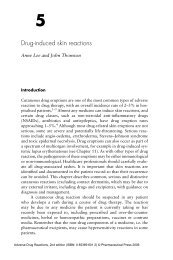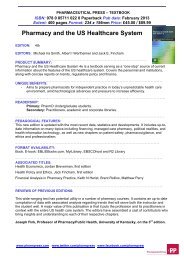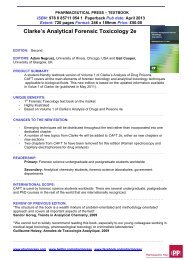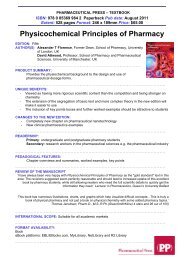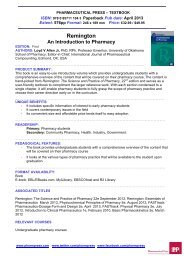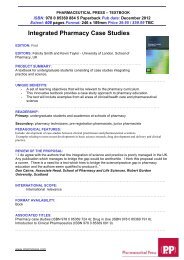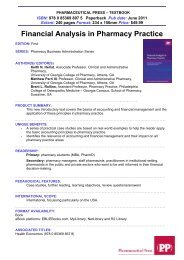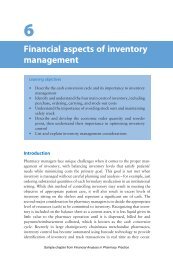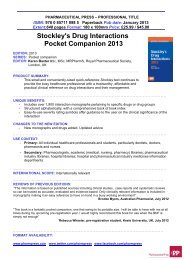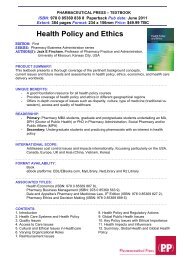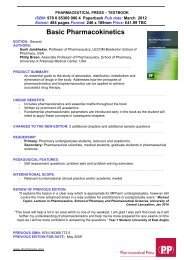11 Chap 11 (bc/d) - Pharmaceutical Press
11 Chap 11 (bc/d) - Pharmaceutical Press
11 Chap 11 (bc/d) - Pharmaceutical Press
You also want an ePaper? Increase the reach of your titles
YUMPU automatically turns print PDFs into web optimized ePapers that Google loves.
208 <strong>Chap</strong>ter <strong>11</strong> • Formulation and physical properties of soft capsules<br />
in such a way as to reduce the tendency of propylene<br />
glycol to migrate, during production and on<br />
storage, by using it as a plasticizer component in<br />
the shell and adjusting the manufacturing conditions<br />
at the drums to reduce tackiness of the<br />
ribbons (Brox et al., 1993; Woo, 1997). An<br />
additional benefit of this approach is, that the<br />
amount of water required for dissolving and<br />
melting the gelatin may be reduced owing to the<br />
lower viscosity of propylene glycol compared to<br />
glycerol and sorbitol solutions, thus reducing the<br />
overall water exchange between shell and fill.<br />
The problems associated with the use of a<br />
volatile solvent such as ethanol are more difficult<br />
to solve. To prevent volatilisation of ethanol, the<br />
finished capsules have to be enclosed in a solventtight<br />
packaging material such as an aluminium<br />
blister. Moreover, replacement of glycerol by<br />
higher polyols such as xylitol, sorbitol, sorbitol/<br />
sorbitan blends and/or hydrogenated starch<br />
hydrolysates has been reported as an effective<br />
means of reducing the rate and extent of ethanol<br />
diffusion into the shell (Reich, 1996; Moreton and<br />
Armstrong, 1998). In certain cases, however, both<br />
approaches may not be sufficient to prevent fill<br />
deterioration, since ethanol diffusion cannot be<br />
fully prevented. Thus, for a microemulsion preconcentrate<br />
formulation that is very sensitive to<br />
the co-solvent concentration, the only way to<br />
overcome the problem at present, is the use of a<br />
co-solvent other than ethanol, that is not volatile<br />
and does not show any diffusion into the capsule<br />
shell. For ciclosporin microemulsion preconcentrate<br />
soft capsules, such approaches have been<br />
filed in two patents, namely a European Patent<br />
Application (Woo, 1995) describing the use of<br />
dimethylisosorbide and a US Patent Application<br />
(Shin et al., 2000) that describes the use of a<br />
microemulsion preconcentrate containing a<br />
lipophilic instead of a hydrophilic co-solvent.<br />
Post-treatments and coatings<br />
Soft gelatin capsules may be post-treated after production<br />
or coated to improve product stability, to<br />
modify the dissolution rate and to enable enteric<br />
capsules to be produced. Several patents have<br />
been filed describing the use of protective coatings<br />
to overcome the stability problems of soft<br />
capsules arising from the hygroscopic nature and<br />
heat sensitivity of the soft capsule shell. However,<br />
most of these attempts have failed in practice,<br />
since coating of soft capsules is not an easy task.<br />
The low surface roughness of soft capsule shells<br />
and the intrinsic insolubility of the shell components<br />
in organic solvents means that coatings<br />
applied as an organic solution usually do not<br />
adhere properly to the capsules, resulting in<br />
onion-like coatings of layers peeling off immediately<br />
after drying or on storage. Aqueous coatings,<br />
on the other hand, may result in capsule swelling,<br />
softening and/or sticking together, since water is<br />
acting as a plasticizer for the gelatin capsule shells.<br />
To balance the two extremes, emulsion-based<br />
formulations or solutions in a mixture of water<br />
and alcohol have been recommended (Osterwald<br />
et al., 1982). The technological approach of choice<br />
for soft capsules to be coated is using the fluidisedbed<br />
air-suspension technique.<br />
Capsules with modified dissolution characteristics,<br />
such as gastroresistant enteric soft gelatin<br />
capsules, have been described in the scientific<br />
and patent literature and can be achieved by<br />
adding gastroresistant, enteric-soluble polymers<br />
to the gelatin mass prior to capsule formation, or<br />
by aldehyde post-treatment or enteric coating of<br />
the dried capsules. All three attempts have their<br />
specific difficulties. For soft gelatin capsules produced<br />
by the rotary die process, the last two<br />
approaches are in practical use.<br />
Aldehyde post-treatment of soft gelatin capsules<br />
has been known for many years as a popular<br />
means to reduce their dissolution rate, i.e. the<br />
capsules take a long time to dissolve and have left<br />
the stomach before this occurs. Formaldehyde<br />
has been described to cross-link effectively soft<br />
capsules to render them gastroresistant. Since<br />
safety questions have been raised about the<br />
presence of trace amounts of formaldehyde in<br />
foods and pharmaceuticals, the use of aldehydes<br />
without health concerns such as aldoses have<br />
been claimed in a patent (Fischer, 1986) and are<br />
actually used. The major disadvantage of any<br />
aldehyde treatment of soft gelatin capsules is that<br />
cross-linking can continue on storage. Alternatively,<br />
soft gelatin capsules may be coated with a<br />
gastroresistant, enteric-soluble polymer. Owing<br />
to the aforementioned difficulties associated with<br />
organic and aqueous soft capsule coating, a



